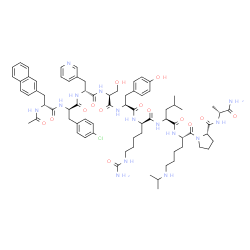151272-78-5
| Name | teverelix |
|---|---|
| Synonyms |
7079
D19V7048JK N-Acetyl-3-(2-naphthyl)-D-alanyl-p-chloro-D-phenylalanyl-3-(3-pyridyl)-D-alanyl-L-seryl-L-tyrosyl-N6-carbamoyl-D-lysyl-L-leucyl-N6-isopropyl-L-lysyl-L-prolyl-D-alaninamide (2S)-N-[(2R)-1-Amino-1-oxo-2-propanyl]-1-[(2S,5S,8R,11S,14S,17R,20R,23R)-8-[4-(carbamoylamino)butyl]-20-(4-chlorobenzyl)-11-(4-hydroxybenzyl)-14-(hydroxymethyl)-5-isobutyl-2-[4-(isopropylamino)butyl]-23-(2-naphthylmethyl)-4,7,10,13,16,19,22,25-octaoxo-17-(3-pyridinylmethyl)-3,6,9,12,15,18,21,24-octaazahexacosan-1-oyl]-2-pyrrolidinecarboxamide teverelix |
| Description | Teverelix (EP 24332) is a GnRH antagonist. Teverelix binds competitively and reversibly to GnRH receptors, thereby suppressing the release of LH and FSH. Teverelix can be used in the research of prostatic hyperplasia, endometriosis, and prostate cancer[1][2]. |
|---|---|
| Related Catalog | |
| In Vitro | Teverelix (10 nM, 45 mins) inhibits GnRH-induced intracellular Ca2+ increase in HEK293/GnRHR cells[2]. Teverelix (0.1 nM-1 μM, 45 mins) inhibits GnRH-induced cAMP accumulation in HEK293/GnRHR cells[2]. Teverelix (10 nM-1 μM, 15 mins) inhibits GnRH-induced pERK1/2 and pCREB activation in HEK293/GnRHR cells[2]. Teverelix inhibits histamine release in a peritoneal rat mast cell, with an EC50value of 81 μg/mL[3]. Western Blot Analysis[2] Cell Line: HEK293/GnRHR cells Concentration: 10 nM, 100 nM, 1 μM Incubation Time: 15 mins Result: Inhibited GnRH-induced pERK1/2 and pCREB activation. |
| In Vivo | Teverelix (3-300 μg/kg, intramuscular injection) inhibits testosterone in rats[3]. Teverelix (1 mg/kg, s.c, daily for 3 days) abolishes luteal function in stumptailed macaques[4]. Animal Model: Rats[3] Dosage: 300, 100, 30, 10 and 3 μg/kg Administration: Intramuscular injection Result: Showed dose-response and time-course of testosterone inhibitory activity. |
| Density | 1.3±0.1 g/cm3 |
|---|---|
| Boiling Point | 1692.9±65.0 °C at 760 mmHg |
| Molecular Formula | C74H100ClN15O14 |
| Molecular Weight | 1459.131 |
| Flash Point | 977.6±34.3 °C |
| Exact Mass | 1457.726318 |
| LogP | 4.49 |
| Vapour Pressure | 0.0±0.3 mmHg at 25°C |
| Index of Refraction | 1.597 |
